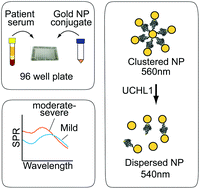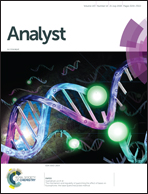Early and rapid detection of UCHL1 in the serum of brain-trauma patients: a novel gold nanoparticle-based method for diagnosing the severity of brain injury
Abstract
The clinical diagnosis of traumatic brain injury (TBI) is based on neurological examination and neuro-imaging tools such as CT scanning and MRI. However, neurological examination at times may be confounded by consumption of alcohol or drugs and neuroimaging facilities may not be available at all centers. Human ubiquitin C-terminal hydrolase (UCHL1) is a well-accepted serum biomarker for severe TBI and can be used to detect the severity of a head injury. A reliable, rapid, cost effective, bedside and easy to perform method for the detection of UCHL1 is a pre-requisite for wide clinical applications of UCHL1 as a TBI biomarker. We developed a rapid detection method for UCHL1 using surface plasmon resonance of gold nanoparticles with a limit of detection (LOD) of 0.5 ng mL−1. It has a sensitivity and specificity of 100% each and meets an analytical precision similar to that of conventional sandwich ELISA but can be performed rapidly. Using this method we successfully detected UCHL1 in a cohort of 66 patients with TBI and were reliably able to distinguish mild TBI from moderate to severe TBI.



 Please wait while we load your content...
Please wait while we load your content...